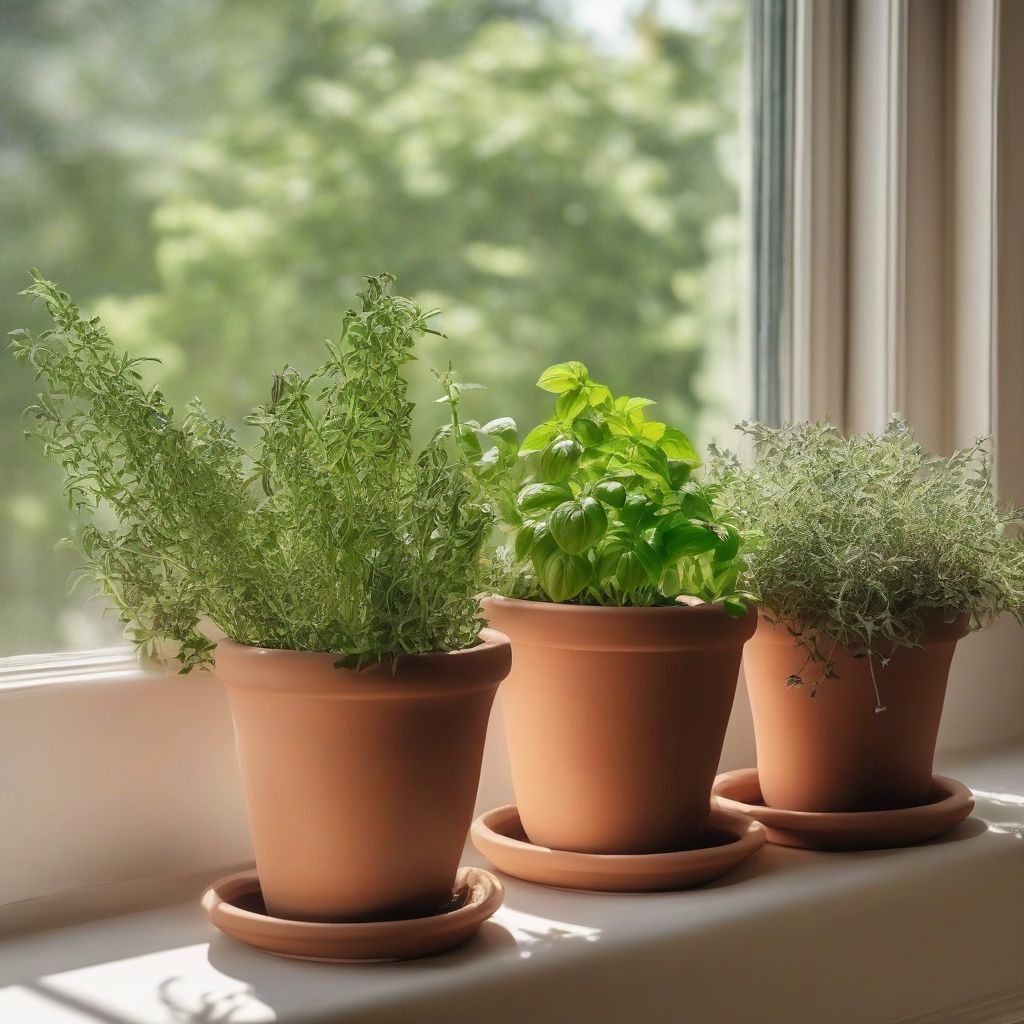Have you ever dreamt of plucking fresh, juicy tomatoes straight from your backyard to make the perfect salad? Or maybe you long for the sweet smell of basil wafting through your kitchen window? What if I told you that you can experience the joy of gardening, even if you don’t have a sprawling lawn? That’s the beauty of container gardening! It’s accessible, manageable, and allows you to grow your favorite herbs, vegetables, and flowers right outside your doorstep, no matter how limited your space.
This beginner’s guide will walk you through everything you need to know to kickstart your container garden journey and reap the bountiful rewards of homegrown goodness.
Choosing the Right Containers
 Terracotta pots with fresh herbs
Terracotta pots with fresh herbs
The first step to establishing a thriving container garden is selecting the right containers. While it’s tempting to repurpose any old bucket or pot, your plants will flourish in a conducive environment. Here’s what to consider:
1. Size Matters
Choose containers appropriate for the plants you want to grow. Smaller herbs and flowers do well in pots 6-12 inches in diameter, while larger vegetables like tomatoes and peppers require containers at least 18-24 inches wide and deep to accommodate their root systems.
2. Drainage is Key
Ensure your chosen containers have adequate drainage holes to prevent waterlogging, which can lead to root rot and hinder plant growth. If a container lacks drainage holes, you can easily drill some yourself.
3. Material Matters
Containers come in various materials, each with pros and cons.
- Terracotta: These porous pots allow for good airflow but tend to dry out quickly.
- Plastic: Lightweight, inexpensive, and retain moisture well, making them ideal for beginners.
- Wood: Aesthetically pleasing and provides good insulation but can rot over time.
- Metal: Can get very hot in the sun, potentially harming plant roots.
Ultimately, the best material depends on your budget, aesthetic preferences, and the specific needs of your plants.
Selecting the Perfect Soil
Don’t underestimate the importance of good soil! Using regular garden soil in containers can lead to poor drainage and compaction, suffocating your plants. Opt for a lightweight, well-draining potting mix specifically designed for containers. These mixes often contain ingredients like peat moss, perlite, and vermiculite, which enhance drainage and aeration.
Picking Your Plants
Now for the fun part – choosing what to grow! The possibilities are endless, but start with plants that suit your taste buds and climate.
1. Herbs for Flavor
Herbs are a fantastic starting point for beginner container gardeners. They’re relatively low-maintenance, thrive in smaller pots, and add a burst of fresh flavor to your culinary creations. Some easy-to-grow options include:
- Basil: This versatile herb thrives in warm, sunny spots and pairs well with Italian dishes.
- Mint: A vigorous grower, mint prefers partial shade and adds a refreshing touch to beverages and desserts.
- Chives: These onion-flavored herbs tolerate a range of conditions and add a subtle kick to salads and dips.
2. Vegetables for Freshness
Imagine harvesting your salad greens right from your balcony! Many vegetables thrive in containers, providing you with a bounty of fresh produce. Consider these beginner-friendly options:
- Tomatoes: Choose determinate varieties (bush-type) that stay more compact for container growing.
- Lettuce: Plant different lettuce varieties for a continuous supply of fresh salad greens.
- Peppers: Both sweet and hot peppers do well in containers and add a kick to your meals.
3. Flowers for Beauty
Don’t forget about flowers! Add a splash of color and attract beneficial pollinators to your container garden with these easy-to-grow beauties:
- Petunias: These vibrant flowers bloom profusely throughout the summer and tolerate various conditions.
- Marigolds: Known for their cheerful blooms, marigolds also deter pests.
- Zinnias: These drought-tolerant flowers come in a rainbow of colors and attract butterflies.
Planting and Care
Once you have your containers, soil, and plants ready, it’s time to get planting! Follow these general guidelines:
- Fill your containers: Leave about an inch of space below the rim to allow for watering.
- Gently remove plants from their nursery pots: Loosen any circling roots at the bottom.
- Plant at the same depth they were in the nursery pot: Water thoroughly after planting.
Ongoing Maintenance
Congratulations, your container garden is off to a great start! Now, it’s all about providing the right care to ensure your plants thrive.
1. Watering Wisely
Container gardens tend to dry out faster than traditional gardens, so regular watering is crucial. Water deeply when the topsoil feels dry to the touch, ensuring excess water drains out of the drainage holes.
2. Feeding Your Plants
Container-grown plants benefit from regular fertilization to replenish nutrients in the potting mix. Use a balanced, water-soluble fertilizer every 2-4 weeks during the growing season.
3. Sunlight Requirements
Most edible plants thrive in at least 6 hours of direct sunlight per day. However, specific light requirements vary depending on the plant. Observe your plants and adjust their placement accordingly.
[amazon bestseller=”container gardening”]
Conclusion
Starting a container garden is a rewarding experience that brings the joy of gardening to any space. By following these guidelines and choosing the right plants for your environment, you’ll be well on your way to enjoying a bountiful harvest of fresh herbs, vegetables, and beautiful flowers.
What are you waiting for? Grab your gardening gloves and unleash your inner gardener!
What are your favorite plants to grow in containers? Share your tips and experiences in the comments below!
